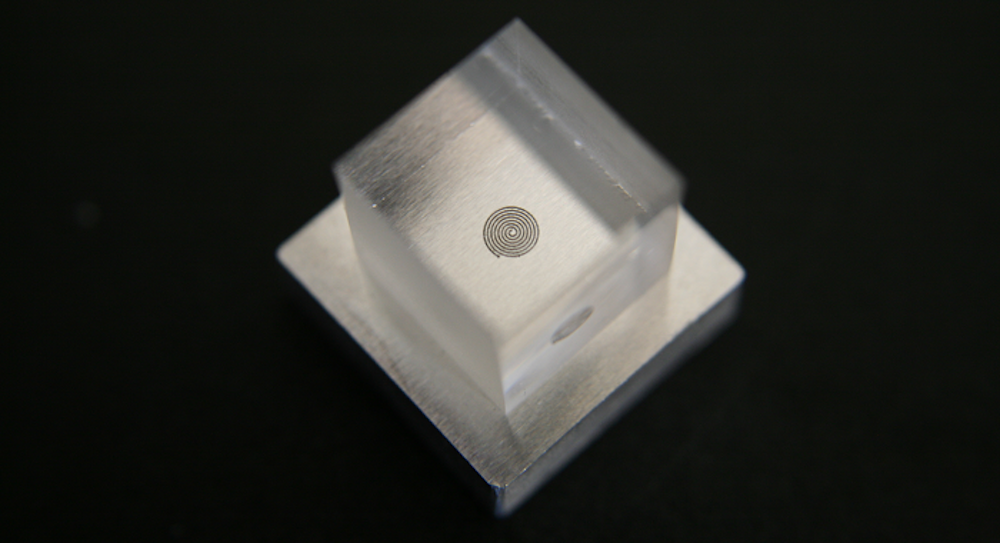
[Image above] Researchers from Heriot-Watt University and industry successfully welded glass and metal together using an ultrafast laser microwelding process. The spiral weld can be seen at the glass–metal interface. Credit: Heriot-Watt University, Laser Systems Europe
Even though forging a strong bond between opposites is more myth than reality in long-term romantic relationships, it now appears to be reality for materials science research. That’s because researchers at Heriot-Watt University (Edinburgh, Scotland) accomplished a feat once thought impossible: direct welding of glass and metal.
“Traditionally it has been very difficult to weld together dissimilar materials like glass and metal due to their different thermal properties—the high temperatures and highly different thermal expansions involved cause the glass to shatter,” says Duncan Hand, director of the five-university EPSRC Centre for Innovative Manufacturing in Laser-based Production Processes based at Heriot-Watt, in a Heriot-Watt press release.
Currently, glass and metal are often held together with adhesives, but that process is messy, and parts can gradually move out of place. Additionally, “organic chemicals from the adhesive can be gradually released and can lead to reduced product lifetime,” Hand adds.
Instead of adhesives, the method Hand and his research team used to join glass and metal is a technique of recent interest called ultrafast laser microwelding. As explained in a 2012 article on the technique, ultrafast laser microwelding involves aiming laser pulses at the interface between two materials in quick succession so that heat accumulates at the interface and leads to localized melting. When the laser pulses stop and the material resolidifies, strong and robust bonds form between the materials along the interface.

So far, the majority of research on ultrafast laser microwelding has focused on similar or slightly dissimilar materials (e.g., glass–glass), while research on highly dissimilar materials has concentrated on bonding glass and silicon (for example, this study).
For research on glass and metal welding (examples here and here), Hand and his team explain these previous studies were limited to proof-of-principle demonstrations involving specific material combinations and limited systematic studies. That is why the researchers “aim to move ultrafast microwelding closer to an industrially viable technique through a systematic study of the parameter space for welding and demonstrating accelerated lifetime survivability,” as they explain in their paper.
However, due to the brittle nature of glass, creating enough samples to produce statistically relevant tests of all parameters was impractical—each process parameter set would require at least 20 samples! So the researchers chose to focus only on pulse energy and focal plane for this study.
Even just focusing on pulse energy and focal plane, though, would require more than 1,000 individual welds. To limit the number of required samples, the researchers carried out two tests for each pair of parameters to create a parameter map. They used the map to identify regions of interest to run full, 20-sample tests. After running these tests, they identified an “optimized” set of parameters for accelerated lifetime testing (e.g., thermal cycling).

While the Heriot-Watt press release states various optical materials like quartz, borosilicate glass, and sapphire were all successfully welded to metals like aluminum, titanium, and stainless steel, the actual paper focuses on welding two specific glasses [Spectrosil 2000 (SiO2) and Schott N-BK7 (BK7)] to 6082 aluminum alloy (Al6082).
The researchers found a single-pass process was sufficient to wield BK7 and Al6082 together, but SiO2 and Al6082 required two passes, likely due to the roughness of the aluminum surface. Despite this difference in weld mechanism, “the optimal weld parameters in each case are very similar and easily within the capabilities of one laser system,” the researchers explain in the paper.
When discussing the results, one somewhat counterintuitive finding the researchers highlight is that minor cracking around the melt volume (particularly in the glass) indicates a good weld. Cracking is due to the significant difference in thermal expansion between glass and metal—through cracking, glass relieves itself of the thermal stress that occurs during cooling. “[This cracking] does not indicate a reduction in the weld strength,” the authors stress.
In the future, the authors note that further work in thermal compensation, either through interlayers or surface patterning to relieve thermal stress, is needed to develop a reliable welding process, “particularly for material combinations with a large mismatch of thermal expansion, e.g., Al6082–SiO2.”
For now, Hand and his team are working with a consortium led by Oxford Lasers, a laser micromachining systems integrator, and laser specialists Coherent Scotland, as well as Leonardo and Gooch & Housego, both end-users of the technology, to develop a prototype to take the laser processing system closer to commercialization. Two other partners, Glass Technology Services and the Centre for Process Innovation, provide additional routes to commercialization, including in packaging of OLED devices.
The open-access article, published in Applied Optics, is “Towards industrial ultrafast laser microwelding: SiO2 and BK7 to aluminum alloy” (DOI: 10.1364/AO.56.004873).
